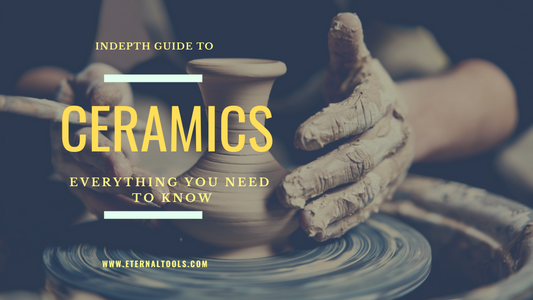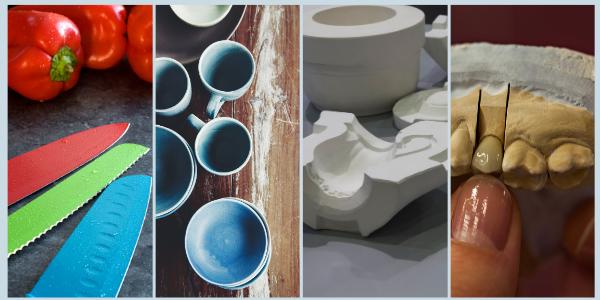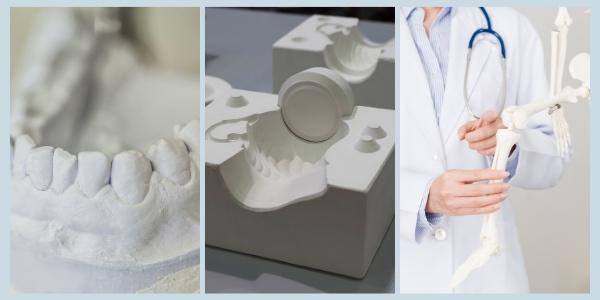Also known as ‘plastic art’, the word “ceramic” is derived from a Greek word keramos which means “potter’s clay”. Objects are created and crafted with clay and hardened through heating at high temperatures then decorated with glaze or painting.
Due to the advancements in technology, 'ceramic' now covers a wider group of materials such as cement and glass, clay not being considered anymore as a key element. Ceramic art has different forms such as earthenware, porcelain, maiolica, raku, celadon and stoneware, pottery, tableware, sculptures and tiles.
Modern ceramics used in engineering, electronics and a multitude of other industries can be made from inorganic and non-metallic products.
Both ceramics and pottery are considered ‘visual arts’. Both have the same processes of shaping, heating, glazing and then re-baking to harden the final product. Fine art pottery focuses more on aesthetics and decoration of the product, and pottery refers to crafting of pots and figurines in a traditional way.
Types of Ceramics
Today the term ceramic has a far broader meaning.
There are traditional ceramics such as:
- Earthenware
- Porcelain
- Stoneware
- Bone China
Then there are modern ceramics, all of which are classified as advanced engineering ceramics:
- Titanium carbide
- Tungsten carbide
- Glass ceramics
- Silicon and silicon carbide
- Fired bricks
- Bio ceramic
Earthenware
Earthenware is considered as the oldest form of pottery, dating back to the stone age. The main composition of earthenware is 25% ball clay, 32% quartz, 28% kaolin clay and 15% feldspar.
Earthenware is the softest form of pottery because it is porous, can be scratched easily, and is heated at a very low temperature.
A glaze can be applied to make it waterproof and then re-fired in a kiln. The iron content in the clay along with the oxygen that is present in the kiln during firing gives shades to the object; cream, dark red, black or grey are common shades.
One of the most famous and ancient types of pottery we’re familiar with are the Chinese clay warriors ‘The Terracotta Army’

Stoneware
As the name indicates, the structure and character of stoneware pottery is dense, opaque and stone-like. Waterproof and naturally grey in colour, it turns brown after firing. The temperature for heating stoneware is around 1,000°C to 13,00°C.
This type of pottery is usually used for manufacturing commercial ware, and for fine art pieces by the likes of Bernard leach, Beate Kuhn and Grayson Perry to name but a few.
The first ever stoneware pottery was created in the era of the Shang Dynasty in China during 1400 BCE. At first, this pottery appeared in Germany in the 15th century and then in 17th century English artists started creating a salt-glazed form of stoneware. The development of stoneware was seen when an artist named Josiah Wedgwood created black stoneware (basalts) and white stoneware also called Jasperware.
Porcelain
Due to the similar structure, the difference between porcelain and stoneware is unclear. Chinese ceramists define it as “an item that provides a ringing tone when being tapped”. In the west, it is differentiated from stoneware by the translucency when it is exposed to light. The combined statement of European communities in this regard is “stoneware is different from porcelain as it is opaque and only partially vitrified”.
Originating from China, it first appears in the Han Dynasty and then the Tang Dynasty, whee it was made with china or kaolin clay and feldspar rocks. In the 16th century, artists created variations in porcelain by adding glass to clay, making it ‘soft porcelain’. In the 1700s, in Germany, the hard type of porcelain was discovered by the famous ceramist Ehrenfied Walter Von and an alchemist Johan Friedrich Bottger when they started using Feldspathic rock rather than glass.
The naturally occurring porcelain clay is white or cream and after firing it becomes just white. The typical temperature for firing porcelain is 1200 to 1450°C, which is slightly higher than stoneware.
Bone China
Bone china is the toughest type of porcelain. It is well known for having a strong resistance against damage, a high mechanical strength and good chip resistance. Famous ceramicist Josiah Spode added powdered bone ash to the feldspar, calcium phosphate and kaolin clay, which in turn created bone china, a form of porcelain that is naturally white in colour and translucent.
Properties of Ceramics
Just as any other material, the properties of ceramics are defined according to the type and bonding of atoms present in it, of which there are two: ionic and covalent bond.
The Ionic bond is present between the two elements having different electronegativity, whereas the covalent bond is found in the materials having the same electronegativity.
The atoms found in ceramics have both types of bonds with the ionic bond being the dominant one.
These two bonds together are responsible for various types of properties in ceramics, which are listed below:
- High levels of hardness.
- Increased level of elastic modulus.
- Low ductility.
- Good wear resistance.
- Extreme resistance to corrosion and chemicals
- High dimensional stability.
- Resistance to weather and atmosphere.
- High melting points.
- Ability to withstand very high temperatures.
- Low coefficients of thermal expansion
- Low to medium thermal conductivity.
- High capacity of brittleness.
- Good electrical insulators.
- Poor impact strength
- Low to medium tensile strength.
- High compressive strength.
- Usually opaque (or translucent in the case of porcelain)
- Less resistance towards thermal shock.
Advantages and Disadvantages of Ceramic
As evident from the above discussion, ceramics like all other materials, tend to have some advantages and disadvantages too, which are mostly derived from their properties.
Advantages
- Relatively harder structure than conventional metals.
- Low coefficient of friction
- They have extremely high melting points.
- They have low density.
- They tend to show high corrosion resistance.
- Low cost.
- Abundant.
- Glazed ceramic is non-staining.
- Excellent electrical insulation.
Disadvantages
- Poor shock resistance.
- Easily breakable when hit with heavy item or dropped.
- Potential warping during firing cause wavering dimensional tolerances.
Applications & Uses of Ceramics
- Tiles: for home decoration, aerospace.
- Cutting tools: For industry and cookware knives.
- Cars: ceramic components and catalytic converters.
- Bricks
- Tooling. Tungsten carbide and silicon carbide.
- Technical ceramics industry.
- Ceramic moulding industry.
- Sanitary ware: toilets, sinks, baths.
- Cookware: knives, crockery, pots, pans, dinnerware.
- Electronic devices: Computer microchips, insulators, motors.
- Hip replacements and dental fixtures.
- Aerospace, aeronautics.
Medical Applications of Ceramics
Bio-materials are those materials which are suitable for use in the human body, and ceramic is one of them, along with metals, polymers and composites. The ceramics used in medicine or biology are known as bio-ceramics, they are used to repair and rebuild human body parts. Some of the applications of bio-ceramics in the medical field are:
- Joint replacements
- Insertion of artificial tendons and ligaments
- Dental implants
- Ultrasound waves used in pregnancy scans
- Bone filler which promotes natural bone growth
Electronic Applications of Ceramics
Ceramic-based materials are vital in products such as smartphones, laptops, televisions, the automotive industry and devices for medical uses. Advanced research in ceramics proved them to be great insulating devices which possess excellent magnetic properties. The main uses of ceramics in electronics are:
- Spark plugs
- Ceramic arc tubes
- Wires and power lines for electricity
- Ceramic batteries for vehicles
- Multilayer ceramic capacitors
- Ceramic resistors and inductors
- Piezoelectric ceramics used in filters, acoustic elements, robotics, automotive and energy harvesting.
- Ceramic-glass used in flexible panels of televisions and smartphones.
Industrial Application of Ceramics
With the advancement of technology, the traditional method of making ceramics has been replaced by modern day methods in laboratories or industries under the supervision of experts and scientists. Through variation in composition, ceramics can be included into many industrial products and are called industrial or advanced ceramics. The properties of ceramics like high wear resistance, high melting points, thermal stability and resistance to corrosion make them ideal for industrial use. Some of the advanced ceramics are listed below:
- Alumina ceramic, made from aluminium oxide is a widely used form of advanced ceramics. This is made through pressing, moulding, extrusion, grinding and laser machining. Due to its electrical insulation and mechanical strength, it is used in pump components, semiconductor devices, electrical wires and automotive sensors.
- Steatite ceramic is made up of magnesium silicate and is commonly used for insulators for conducting electricity. It has exceptional dialectal strength, low degeneracy and a high mechanical strength. Because of its insulating properties, it is commonly used in thermostats and household electronics.
- Zirconia ceramic is composed of zirconium oxide and has excellent tolerance against corrosion and abrasion so is often used in ball bearings and grinding or abasive items and tools. It has ‘fracture toughness’, making it useful for manufacturing dental ceramic implants and oxygen sensors in vehicles.
- Silicon Carbide: Sintering is a process in which the elements of silicone carbide are pressed together to form a strong ceramic bond and because of its hardness, silicon carbide ceramic is used in tools and abrasives, car brakes, car clutches, plates made of ceramic and bullet proof vests.
- Cordierite ceramic is formed through argillaceous rocks (e.g shale, slate) and is mainly used for heat conductors in gas turbines due to its high thermal shock resistance.
- Mullite, an uncommon silicate metal is formed under high temperatures and low pressure. Its low thermal conductivity and expansion, and extraordinary stability when exposed to chemical attacks make mullite ceramic advantageous for use in thermocouple protection tubes, furnace components and kiln rollers.
Ceramics in Construction and Housing
Durability and high corrosion resistance make ceramics the best choice for construction and home decoration. Its stability in all types of weather makes it the perfect choice. Some of the uses are:
- Ceramic bricks and roof tiles are commonly used in every house because they are non-toxic and do not emit any volatile organic compounds. They provide insulation whilst being heat, sound and fire resistant.
- Floor and wall tiles made today can have a coatings making them antibacterial or for the water to slide off easily. The innovative form of ceramic tiles includes fibre-reinforced ceramics, conductive layers for heating and porous layers for insulation.
- Ceramic drainage pipes take water safely away from houses and to the grounds. The composition of clay pipes is natural and organic, and recyclable.
- Wash basins, toilets, bath tubs and seats. Being durable, sanitary ware in many houses are made from Ceramic.
Ceramic Consumer Goods
- Tableware, vessels, utensils, china ware and ornamentals. The various designs, durability and heat resistance properties make ceramic an ideal choice.
- Heating and cooking appliances. The stability of ceramics at high temperatures makes ceramics ideal for heating and cooking appliances. Non-stick ‘green’ pans and ceramic-coated utensils.
Other Industrial Applications for Ceramics
- Ceramic abrasives in the Abrasive Industry. Most machinery used in industries for kitchen appliances, watches, diamonds and aircraft parts are sanded, ground and polished with ceramic abrasives. The European abrasive industry is increasing to various other fields such as the steel, glass, automobile and wood processing industries.
- Refractory ceramics. Due to its mechanical strength, corrosion resistance and thermal insulation, the use of refractory ceramics in the steel, aluminium, cement and glass industries is widely used.
- Porcelain enamel is used to coat metal products such as hot water tanks, pans, cookers and sanitary ware to help prevent scratching and chemical acid attacks.
High-Tech Innovations in Ceramic Appliances
Ceramic has become essential in high tech appliances due to its unique electrical, chemical, mechanical and thermal properties. Some of the industries that use ceramics are:
- Medical devices
- Electronic industry
- Security and transport: bullet proof jackets and infra-red night devices.
- Aerospace technology
- Automotive industry
- Glass factories for solar panels and silicon wafers.
Crafting of Ceramics
The crafting of pottery or ceramics includes various steps starting with collecting the raw clay that consists of feldspar, quartz, mica, iron-sulphides and various other materials. Earthenware is usually crafted from the naturally occurring clay, whereas other forms of pottery are made by mixing the clay with other ingredients to produce the desired product.
According to the US geological survey, there are six types of clay mined in the USA:
- Common clay used for bricks and cement.
- Kaolin or china clay used for making shiny papers and stomach medicine.
- Bentonite clay is processed for drilling mud and can be seen in various household products.
- Ball clay is a high quality clay used for tiles and sanitary-ware.
- Fuller’s earth used for pet waste products.
- Fire clay is processed for high temperature manufacturing of bricks and cement.
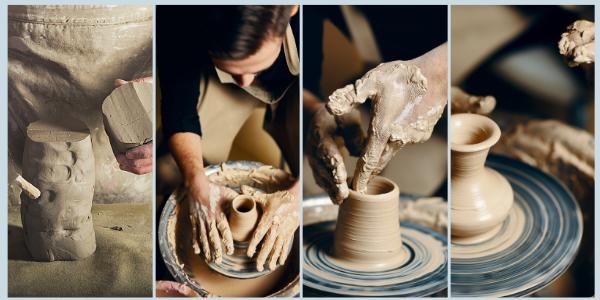
Shaping of the clay body. Manual methods include pinching, coiling, or using a potters wheel. Industrial mechanical methods use moulds or a mechanical jolly or jigger. Once the preferred shape is achieved, it is dried then heated. Some artists also use the “wet fired” process as can be seen in Jane Jermyn Ceramics.
Firing is done once the clay has been dried. The dried material is baked in a kiln or furnace and the temperature is set according to the type of pottery required. For years pottery artists used various types of traditional kilns such as the cave or ‘Anagama’ wood kiln by Oxford University as can be seen in Wytham Woods, Oxfordshire. Potters and modern industries now use electric or gas kilns.
The Reheating method is done to melt the fired glaze so that it can seal tightly around the item.
Reshaping can be done in instances where a vessel requiring a flat base has distorted during heating. After heating, the bottom can be grinded to make it smooth again.
Decoration
Decoration of the clay body can be done pre or post firing.
1. Stamping: Designs and reliefwork are stamped or embossed on to the clay.
2. Carving: Indents, sgraffito, marks and impressions are made in the unheated clay body.
3. Slip: Once fired a slip is applied to the piece to creative decorative effects.
4. Glazing: A fired item is covered in glaze for shine and decoration and to make the ceramic waterproof. Four kinds of glazes are used for this purpose: feldspathic, salt, tin and lead. Earthenware is glazed with tin and lead, whereas stoneware is usually salt-glazed.

5. Polishing: Some earthenware made from natural clays are polished after heating.
6. Maiolica: This is a tin-glazed style of pottery. After heating, the item is dipped in liquid glaze and hand painted before firing it again. The metal oxides present in the paint react with the glaze to produce beautiful colours.
7. Painting: Over-glaze painting is when the painting is done post-firing and post-glazed. Under-glaze painting is done pre-firing and pre-glaze.
8. Gilding: Metallic mixtures of different metals such as powdered gold, platinum, silver or copper are used and applied to a fired item. Gold produces a purple hue, silver produces a yellow colour, copper forms a variety of yellow - brown hues, and platinum a silver colour.
9. Printing: this decoration step includes transfer printing.
Tools For Use On Ceramics
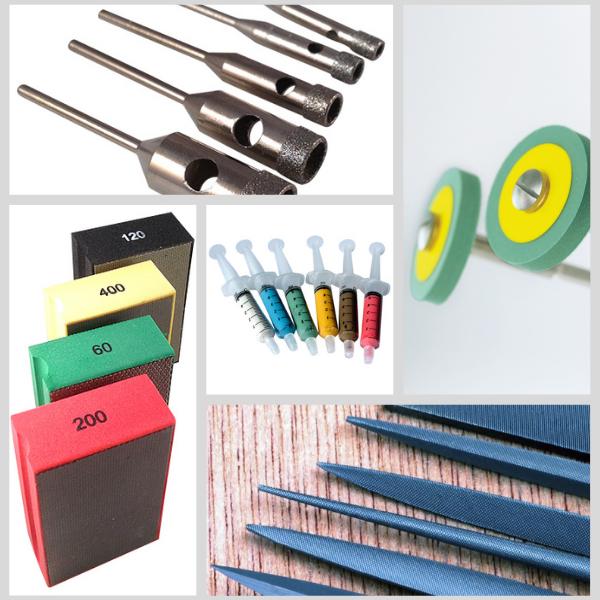
1. Diamond Core drills and small diamond drill bits are often used in the manufacturing of industrial and technical ceramic moulds.
2. Diamond files, and diamond hand pads are used for removing kiln wash and glaze drips.
3. Diamond slitting discs and diamond cutting wheels are used for slicing and cutting
4. Diamond burrs are used for grinding, shaping and carving ceramics
5. Diamond grinding paste, diamond cloths and EVE Diapol diamond polishers are used to smooth, pre-polish and polish ceramics.
6. Diatwist single disc polishers are ideal for smoothing and deburring intricate ceramic moulds.
7. Eve Mini Rubber Silicone Polishers, White and Blue for deburring and smoothing
Polymer Clay
Polymer clay is actually a plastic, Polyvinyl Chloride. Unlike clay as mentioned above, Polymer clay doesn't need to be fired in a kiln, nor will it dry out at room temperature.
Polymer clay can be manipulated and shaped many times over, then oven baked to harden.
Helpful Resource pages:
The English Ceramic Circle is an organisation dedicated to the study of ceramics and may be a helpful resource for anyone wishing to research further.
Ceramic Review magazine.
How to Drill Ceramic and Porcelain Tiles, by Eternal Tools
History of Ceramics
The history of ceramics can be dated back thousands of years ago. In prehistoric times, people found out that clay was abundant and could be moulded into various shapes by mixing it with water and then heating it.
The earliest known artefact is dated from 30,000 BCE, in the time of the late Palaeolithic period. The artefact was a statue of a woman named the Venus of Dolnì Věstonice, found in the Czech Republic. Thousands years later in 18,000 BCE, fragments of pots appeared in East Asia in the Xianrendong Cave in China. After that, archaeologists were finding remains of ceramic models dating back to 14,000 BCE in Japan and Russia.
The use of ceramics rapidly spread in the Neolithic period. In 9,000 BCE, containers for household use were made of ceramic, along with other art objects, tiles and bricks, that reached from Asia to the Middle East and then Europe. The products made at that period were simply dried in the sun or heated at low temperatures in a kiln which was dug in the ground. After drying, the material was painted with simple geometrical motifs or designs.
Sharp objects made from naturally occurring volcanic glass were already used by people in 7,000 BCE. According to a Roman historian, the first man-made glass was produced by accident in 5,000 BCE by merchants on a beach. Cooking pots were placed over sodium-rich rocks near a fire and the rock melted due to high heat, it then mixed with sand and formed molten glass. Simple glass items were found in Mesopotamia and Egypt in 3,500 BCE. Glazed pottery was introduced in Mesopotamia and, then, Egypt started factories to produce glassware in nearly 1,500 BCE.
One of the first revolutions in the manufacturing of ceramics was the invention of the wheel in 3,500 BCE. The use of the wheel in crafting clay created a centrifugal force on the stand inserted on the pinwheel. This concept was also known as throwing pottery. Ceramic pottery evolved with the passage of time and Greeks also started using Attic vases made of ceramic, in 5th and 6th century BCE. In 16th century CE, earthenware was the common ceramic type in the Middle East and Europe, whereas in China Porcelain from Kaolin clay was introduced in 600 CE.
In the 15th century, blast furnaces that could reach up to 15,00°C were introduced into Europe and used to manufacture glass, cement, chemicals and ceramics, revolutionising industry.
Since World War II, glass and ceramics have contributed in the advancement of many fields such as electronics, medical, thermal power plants, automotive industries and space sciences.
--------------------------------------------------------------------------------------------------------------------------------------
Ceramic, a material with extraordinary properties and importance which is evident from its above mentioned applications. Modern industries are becoming dependent on ceramics. With the advancement in technology, ceramics and the glass industry will be some of the driving forces of the global economy in the near future.

